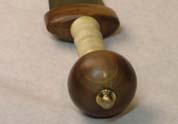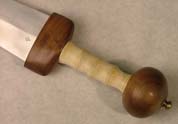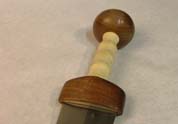|
|

The Allectus
Limited
Edition Roman Gladius
(Mainz style)
The Roman Legions were
renowned for their brutal, efficient use of the short sword and over the
centuries the style of short sword changed as tactics changed or were
refined. Beginning with the "gladius Hispaniensis" (based on
a Celt-Iberian leaf-bladed short sword), over time the sword became shorter
and broader (the Mainz and Fulham patterns) and culminated in the "Pompeii"
style stabbing sword.
The Mainz pattern is thought to have developed from the leaf-bladed short
swords used on the Celt-Iberian peninsula (what is now Spain) and adopted
for use in the Republican Legions. Rather than fighting as individual
warriors (like their competition, the Continental Celts) the Roman legions
eventually developed a new way of fighting -- massing together with overlapping
shields, using their short stabbing'cutting swords to strike from behind
this shield wall. As these battle tactics for the Legions changed, a shorter,
broader stabbing/cutting sword had to be developed to use in combination
with these newer types of shield and new styles of fighting.
The Mainz pattern is deeply waisted and has a long point section like
the earlier gladius Hispaniensis, but is shorter and broader than its
predecessor. Unlike the later Pompeii style, the Mainz pattern was still
capable of delivering strong cutting blows, though its primary purpose
was for thrusting.
The Greek historian Dionysus of Halicarnassus (contemporary to Emperor
Augustus 63 BC-14 AD) describes Roman tactics with swords against the
Gauls in the 4th C BC. Dionysus describes events that is some 300 years
earlier than his own times, but we might perhaps presume that the fighting
techniques he describes were not anachronistic to his own period. It is
during the late 1st C BC that the Mainz type Gladius developed from the
longer Gladius Hispaniensis that the Romans adopted during the Punic wars.
Both the longer Gladius Hispanienis and the Mainz type gladius were effective
cutting swords, even if thrusting was a favoured tactic in close formations.
...Holding their sword straight out, they would strike their opponents
in the groin, pierce their sides, and drive their blows through their
breasts into their vitals. And if they saw any of them keeping these parts
of the body protected, they would cut the tendons of their knees or ankles
and topple them to the ground roaring and biting their shields and uttering
cries resembling the howling of wild beasts...
We can see how the cut was accepted as a perfectly viable method to dispatch
an opponent, if the thrust did not prove effective. Vegetius describes
how recruits are trained using wooden swords against stout posts, as though
attacking different parts of the opponents body. A crippling cut against
the backside of the leg was included in these techniques.
The guard and pommel are hand-crafted of walnut, the grip turned from
holly, and the inset guard plate and pommel nut are of bronze.
A Limited Edition Hand Crafted Collectible Sword
This sword is offered in a limited edition of only 500 collectible swords
worldwide.
Name That Sword Contest Winner:
Roger Hooper
"Allectus is a Roman Army term for a chosen man or elite soldier - I think
it's a good name for a Mainz gladius. (It's also the name of a later Roman
Emperor, but that isn't why I thought of this.)"
Specifications
Overall length: 27.625" (70 cm)
Blade length: 20.25" (51.44 cm)
Blade width: 2.625" (6.67 cm)
CoP: n/a
CoB: 4.125" (10.48 cm)
Weight: 1 lb 11 oz (760 grams)
The Allectus (Mainz Gladius)...
$770
Order
now before this limited
edition collectible sword runs out!.
|







